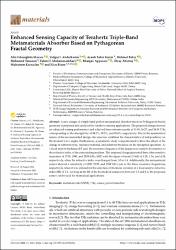Enhanced Sensing Capacity of Terahertz Triple-Band Metamaterials Absorber Based on Pythagorean Fractal Geometry

Göster/
Tarih
2022Yazar
Mazare, Alin GheorghitaAbdulkarim, Yadgar I.
Karim, Ayoub Sabir
Bakır, Mehmet
Taouzari, Mohamed
Muhammadsharif, Fahmi F.
Appasani, Bhargav
Altıntaş, Olcay
Karaaslan, Muharrem
Bizon, Nicu
Üst veri
Tüm öğe kaydını gösterKünye
Mazare, A.G., Abdulkarim, Y.I., Karim, A.S., Bakır, M., Taouzari, M., Muhammadsharif, F.F., Appasani, B., Altıntaş, O., Karaaslan, M., Bizon, N. (2022). Enhanced Sensing Capacity of Terahertz Triple-Band Metamaterials Absorber Based on Pythagorean Fractal Geometry. Materials, 15 (18), art. no. 6364. https://doi.org/10.3390/ma15186364Özet
A new design of a triple band perfect metamaterial absorber based on Pythagorean fractal geometry is proposed and analyzed for terahertz sensing applications. The proposed design showed an enhanced sensing performance and achieved three intensive peaks at 33.93, 36.27, and 38.39 THz, corresponding to the absorptivity of 98.5%, 99.3%, and 99.6%, respectively. Due to the symmetrical nature of the recommended design, the structure exhibited the characteristics of independency on the incident wave angles. Furthermore, a parametric study was performed to show the effects of the change in substrate type, resonator material, and substrate thickness on the absorption spectrum. At a fixed analyte thickness (0.5 mu m), the resonance frequency of the design was found to be sensitive to the refractive index of the surrounding medium. The proposed design presented three ultra-sensitive responses of 1730, 1590, and 2050 GHz/RIU with the figure of merit (FoM) of 3.20, 1.54, and 4.28, respectively, when the refractive index was changed from 1.0 to 1.4. Additionally, the metamaterial sensor showed a sensitivity of 1230, 2270, and 1580 GHz/mu m at the three resonance frequencies, respectively, when it was utilized for the detection of thickness variation at a fixed analyte refractive index (RI) of 1.4. As long as the RI of the biomedical samples is between 1.3 and 1.4, the proposed sensor can be used for biomedical applications.















